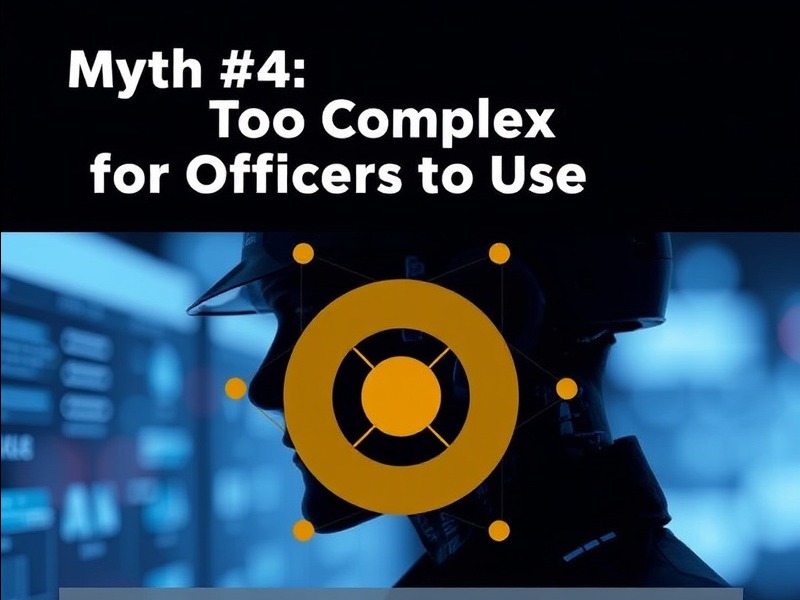As society becomes increasingly driven by technology, the field of law enforcement is no exception. Police departments today rely on quick, accurate communication and data-driven decisions. To meet these demands, many agencies are turning to artificial intelligence (AI)—a powerful tool that is transforming industries worldwide.
AI has the potential to revolutionize police communication by automating routine tasks, streamlining processes, and delivering insights that were previously out of reach. Beyond operational improvements, it offers an opportunity to bridge gaps between law enforcement agencies and the communities they serve by fostering transparency, accountability, and trust.
However, with these advancements come challenges. Many officers and departments feel uncertain about how to integrate AI into their work effectively. Without proper guidance, the potential for missteps, misuse, or even public skepticism can grow. That’s why training in AI isn’t just helpful—it’s essential.
In this article, we’ll explore how AI is reshaping communication strategies in law enforcement, the specific benefits it brings to police departments, and how a structured approach to training can empower officers to harness this technology with confidence.

Whether you're an officer on the front lines, a communication specialist, or a department leader, understanding AI’s role in law enforcement is no longer optional—it’s the key to staying ahead in an ever-evolving field.
The Benefits of AI in Law Enforcement Communication
Artificial intelligence is revolutionizing the way police departments approach communication, offering tools that improve efficiency, accuracy, and public trust. By incorporating AI-driven solutions, law enforcement agencies can address some of the most pressing challenges they face today, while enhancing their ability to serve and protect their communities.
Efficiency: Freeing Up Resources for Critical Tasks
One of the primary benefits of AI is its ability to handle time-consuming, routine tasks, allowing officers and staff to focus on more pressing issues. AI streamlines tasks like analyzing data, drafting incident reports, and coordinating emergency responses. For example:
-
Automated Reports: AI can draft initial reports from officer input, reducing the time spent on paperwork.

Real-Time Data Analysis: AI tools can quickly process crime trends or incident patterns, delivering actionable insights to officers in the field.
Emergency Coordination: AI-driven systems can prioritize calls and optimize resource allocation, ensuring faster response times during crises.
By automating these tasks, departments can save time, reduce errors, and enable their officers to dedicate more energy to their core mission: ensuring public safety.
Accuracy and Consistency: A Unified Voice Across Departments
Effective communication relies on accuracy and consistency, particularly in high-stakes scenarios. AI-powered tools can standardize messaging and ensure that vital information is conveyed clearly and without error. For instance:
Interdepartmental Communication: AI can help maintain a consistent flow of information between departments, eliminating miscommunications that could compromise operations.
Public Messaging: Automated systems can draft press releases, social media updates, or public alerts, ensuring accuracy and alignment with department standards.
-
Report Standardization: AI can enforce formatting and terminology consistency, helping departments meet legal and procedural requirements.

By enhancing accuracy and consistency, AI tools not only improve internal operations but also foster a sense of professionalism and reliability that the public can trust.
Building Community Trust: Transparency and Accountability
In today’s policing landscape, public trust is paramount. AI offers tools that promote transparency and accountability, which are critical for building and maintaining that trust. Here’s how:
Data-Driven Insights: AI can analyze data to uncover patterns, highlight areas for improvement, and provide evidence-based justifications for policing strategies.
Transparent Reporting: Automated systems can create clear, accessible summaries of incidents or departmental performance, helping the public understand how resources are being used.
Accountability Tools: AI can support the review of body camera footage, ensuring that officers and departments adhere to best practices.
When law enforcement uses AI to demonstrate transparency, the result is a stronger bond with the community—a bond built on trust, understanding, and accountability.

Real-World Applications of AI in Law Enforcement
Several law enforcement agencies have successfully integrated AI into their operations, demonstrating the tangible benefits of structured training:
Oakland County, Michigan: During a mass shooting investigation in November 2021, the Oakland County Sheriff's Office utilized AI tools to analyze vast amounts of digital evidence, leading to the swift identification and apprehension of the suspect.
New York Police Department (NYPD): In the manhunt for the assassin of United Healthcare CEO Brian Thompson, the NYPD employed AI-powered facial recognition, drones, and extensive camera networks to track the suspect's movements, illustrating the effective combination of modern technology with traditional police work.
These examples underscore the critical role of AI in modern policing and the necessity for officers to be proficient in these technologies.
The Power of Structured AI Training

Artificial intelligence (AI) is rapidly transforming law enforcement, offering tools that enhance efficiency, accuracy, and community engagement. However, the successful integration of AI into policing hinges on comprehensive and structured training programs that equip officers with the necessary skills and knowledge.
The Importance of Structured AI Training
Structured training ensures all personnel gain a uniform understanding of AI technologies and their applications. This uniformity is crucial in law enforcement, where coordinated efforts and clear communication are vital.
A well-designed training program addresses various aspects of AI integration, including:
Technical Proficiency: Ensuring officers are adept at using AI tools for tasks such as data analysis, surveillance, and communication.
Ethical Considerations: Highlighting the importance of responsible AI use, including privacy concerns and bias mitigation.
-
Legal Frameworks: Educating officers on the legal implications of AI deployment in law enforcement activities.

Ensuring Success with Ongoing Learning
The dynamic nature of AI technology necessitates continuous learning and adaptation. To maintain proficiency and stay abreast of advancements, law enforcement agencies should:
Implement Continuous Education Programs: Regular workshops and seminars to update officers on the latest AI tools and best practices.
Encourage Knowledge Sharing: Facilitate forums where officers can share experiences and insights on AI applications.
Provide Access to Resources: Offer online courses and materials that officers can utilize for self-paced learning.
Addressing Concerns About AI in Law Enforcement
As with any transformative technology, the introduction of artificial intelligence (AI) in law enforcement has sparked a range of questions and concerns. These apprehensions often stem from misunderstandings about how AI works, its limitations, and its role in augmenting—not replacing—traditional policing methods.

Addressing these concerns is crucial to fostering trust, both within law enforcement agencies and among the communities they serve.
Myth #1: AI Will Replace Police Officers
The Concern: Many worry that AI will automate critical aspects of policing, potentially leading to a loss of jobs or the erosion of human judgment in decision-making.
The Reality: AI is not a replacement for officers but a tool to enhance their effectiveness. By automating routine tasks, such as paperwork or data analysis, AI allows officers to focus on critical, human-centered duties like community engagement, investigations, and crisis management. Human intuition, empathy, and judgment remain irreplaceable in law enforcement.
Example: When the New York Police Department (NYPD) used AI facial recognition tools to identify suspects, human officers validated and acted on the AI’s suggestions, ensuring accuracy and ethical decision-making.
Myth #2: AI is Always Accurate
The Concern: There’s a misconception that AI generates flawless results every time, which could lead to overreliance on the technology.

The Reality: AI is only as good as the data it is trained on. If that data contains biases or errors, the outputs will reflect those flaws. Proper training ensures officers understand AI’s limitations and verify its results.
Example: The Oakland County Sheriff’s Office leveraged AI to process digital evidence during a mass shooting investigation but cross-checked all findings with manual analysis to ensure reliability and objectivity.
Myth #3: AI Compromises Privacy
The Concern: Communities often fear that AI tools, particularly those used in surveillance, will infringe on individual privacy rights.
The Reality: Responsible AI use adheres to strict legal and ethical standards to ensure privacy and civil liberties are protected. Departments employing AI must follow guidelines that balance safety with the rights of individuals.
Best Practice: Departments using AI for surveillance or data analysis should engage with community leaders and privacy advocates to establish transparent policies, building trust and mutual understanding.

Myth #4: AI is Too Complex for Officers to Use
The Concern: Officers may feel overwhelmed by the perceived complexity of AI tools, believing that only tech experts can effectively use them.
The Reality: With structured training, AI becomes an accessible and intuitive tool for officers at all levels. Simplified frameworks and hands-on practice demystify AI and build confidence in its application.
Example: A police department in Illinois implemented an AI-driven incident reporting tool, and with just a few hours of training, officers reported significant time savings and ease of use.
Proactively Addressing Concerns
To overcome these misconceptions, departments can take proactive measures, such as:
Community Engagement: Host public forums to explain how AI is used and address concerns about privacy and accountability.
Transparency in Policies: Publish clear guidelines on how AI tools are deployed and the safeguards in place to protect individual rights.
Ongoing Officer Education: Provide regular training sessions to keep officers informed about AI capabilities, limitations, and updates.

Call to Action: Enhance Your Department with AI Training
Law enforcement is at a crossroads where technology and public safety converge. Artificial intelligence offers immense potential to transform police communication, streamline operations, and strengthen community trust. To help departments navigate this evolving landscape, Operation Blue Beat is proud to present a comprehensive AI training workshop designed specifically for law enforcement professionals.
Why Choose Operation Blue Beat's Training?
Operation Blue Beat’s AI training workshop is tailored to address the unique challenges faced by police departments. Unlike generic technology courses, this program dives deep into real-world law enforcement applications, equipping officers and communication specialists with practical tools and strategies.
Key Features of the Workshop:
Practical Applications: Learn how to use AI tools for tasks like report generation, data analysis, and interdepartmental communication.
Law Enforcement-Focused: Understand the role of AI in ethical policing, including privacy safeguards, bias mitigation, and transparency initiatives.
Interactive and Engaging: Participate in hands-on exercises, live demonstrations, and scenario-based learning to build confidence and expertise.
Proprietary Framework: Gain exclusive access to Operation Blue Beat’s proven framework for crafting effective AI prompts, ensuring consistent and accurate outputs every time.
Who Should Attend?
This workshop is designed for:
Police officers looking to streamline their daily tasks with AI-powered tools.
Communication specialists aiming to enhance interdepartmental and public messaging.
Law enforcement leaders seeking to modernize their departments with cutting-edge technology.
Whether you’re an AI novice or have some experience, this workshop will provide actionable insights that can be immediately applied to your role.
What You’ll Gain:
By attending the Operation Blue Beat AI workshop, participants will:
Develop a strong foundational understanding of AI and its capabilities.
Learn how to integrate AI tools seamlessly into day-to-day operations.
Improve communication accuracy and consistency across departments.
Build community trust through transparent and ethical use of AI technologies.
Participants will leave the workshop with practical knowledge, access to resources, and the confidence to use AI as an indispensable tool for modern policing.
How to Enroll
Seats are limited, so act now to reserve your spot in the next session of the Operation Blue Beat AI training workshop. Here’s how you can join:
Visit Our Website: https://operationbluebeat.com/airegister
Contact Us Directly: support@operationbluebeat.com
Discounts are available for early registration and group enrollments; contact us for details.
Empower Your Team Today
Artificial intelligence is the present reality of law enforcement. With the tools and training offered by Operation Blue Beat, your department can lead the way in efficiency, consistency, and community trust.
Don’t miss this opportunity to equip your team with the skills they need to master AI in law enforcement. Reserve your spot today and join the ranks of forward-thinking departments embracing technology for a safer, smarter future.
 Add Row
Add Row  Add
Add 







Write A Comment